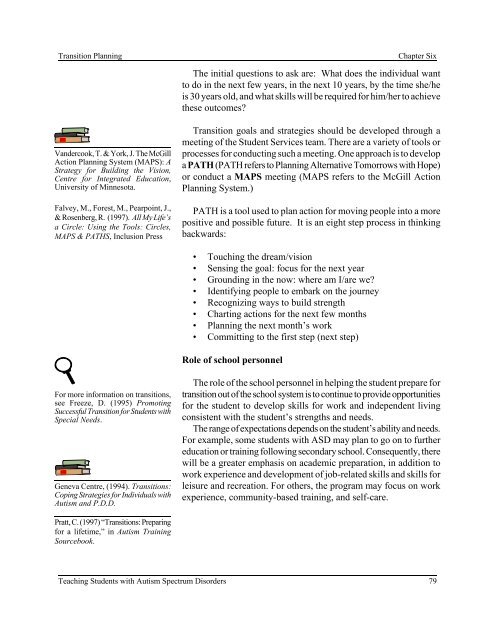Teaching Students with Autism Spectrum Disorders
Teaching Students with Autism Spectrum Disorders
Teaching Students with Autism Spectrum Disorders
Create successful ePaper yourself
Turn your PDF publications into a flip-book with our unique Google optimized e-Paper software.
Transition Planning Chapter Six<br />
Vandercook, T. & York, J. The McGill<br />
Action Planning System (MAPS): A<br />
Strategy for Building the Vision,<br />
Centre for Integrated Education,<br />
University of Minnesota.<br />
Falvey, M., Forest, M., Pearpoint, J.,<br />
& Rosenberg, R. (1997). All My Life’s<br />
a Circle: Using the Tools: Circles,<br />
MAPS & PATHS, Inclusion Press<br />
For more information on transitions,<br />
see Freeze, D. (1995) Promoting<br />
Successful Transition for <strong>Students</strong> <strong>with</strong><br />
Special Needs.<br />
Geneva Centre, (1994). Transitions:<br />
Coping Strategies for Individuals <strong>with</strong><br />
<strong>Autism</strong> and P.D.D.<br />
Pratt, C. (1997) “Transitions: Preparing<br />
for a lifetime,” in <strong>Autism</strong> Training<br />
Sourcebook.<br />
The initial questions to ask are: What does the individual want<br />
to do in the next few years, in the next 10 years, by the time she/he<br />
is 30 years old, and what skills will be required for him/her to achieve<br />
these outcomes?<br />
Transition goals and strategies should be developed through a<br />
meeting of the Student Services team. There are a variety of tools or<br />
processes for conducting such a meeting. One approach is to develop<br />
a PATH (PATH refers to Planning Alternative Tomorrows <strong>with</strong> Hope)<br />
or conduct a MAPS meeting (MAPS refers to the McGill Action<br />
Planning System.)<br />
PATH is a tool used to plan action for moving people into a more<br />
positive and possible future. It is an eight step process in thinking<br />
backwards:<br />
• Touching the dream/vision<br />
• Sensing the goal: focus for the next year<br />
• Grounding in the now: where am I/are we?<br />
• Identifying people to embark on the journey<br />
• Recognizing ways to build strength<br />
• Charting actions for the next few months<br />
• Planning the next month’s work<br />
• Committing to the first step (next step)<br />
Role of school personnel<br />
The role of the school personnel in helping the student prepare for<br />
transition out of the school system is to continue to provide opportunities<br />
for the student to develop skills for work and independent living<br />
consistent <strong>with</strong> the student’s strengths and needs.<br />
The range of expectations depends on the student’s ability and needs.<br />
For example, some students <strong>with</strong> ASD may plan to go on to further<br />
education or training following secondary school. Consequently, there<br />
will be a greater emphasis on academic preparation, in addition to<br />
work experience and development of job-related skills and skills for<br />
leisure and recreation. For others, the program may focus on work<br />
experience, community-based training, and self-care.<br />
<strong>Teaching</strong> <strong>Students</strong> <strong>with</strong> <strong>Autism</strong> <strong>Spectrum</strong> <strong>Disorders</strong> 79

















